Caballero B. (ed.) Encyclopaedia of Food Science, Food Technology and Nutrition. Ten-Volume Set
Подождите немного. Документ загружается.

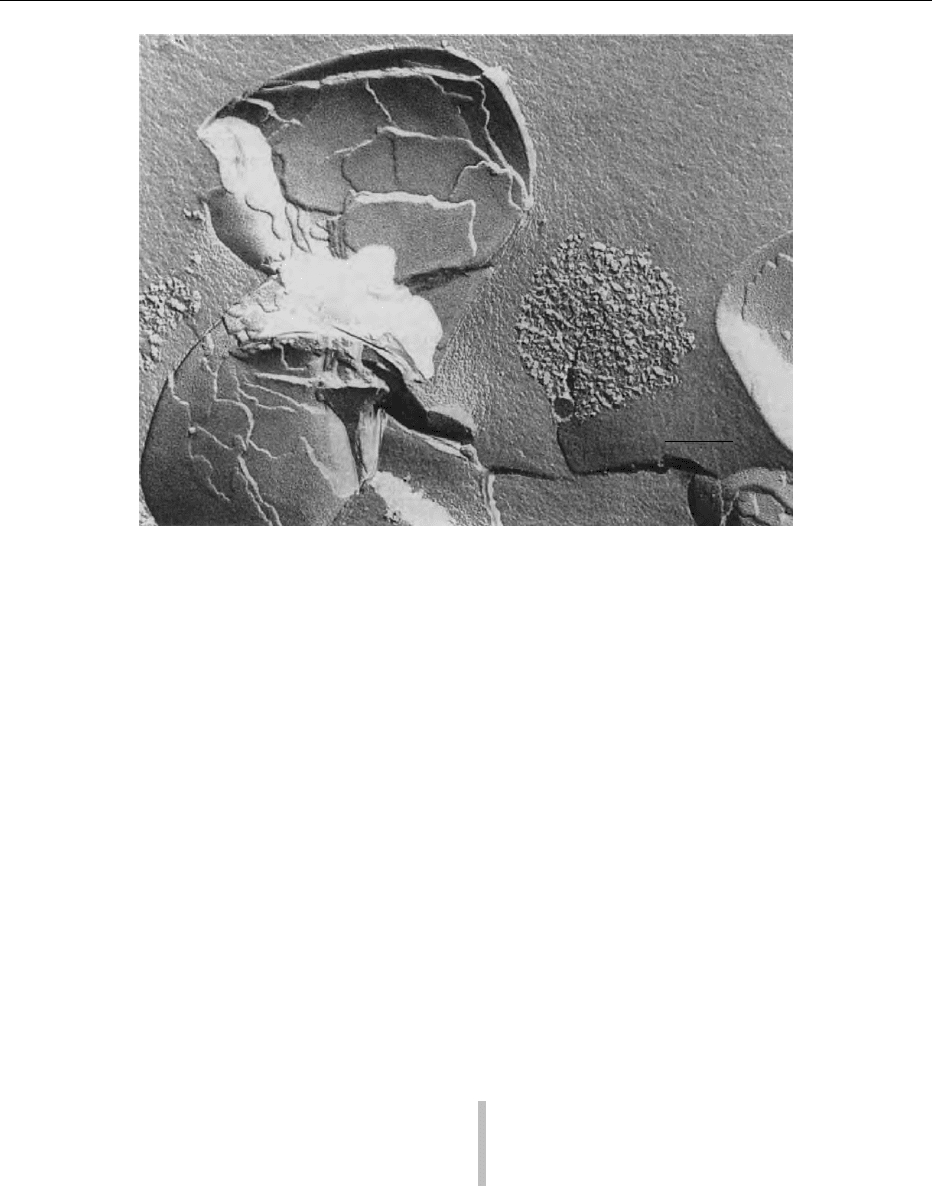
the applications of the different microscopes in this
family extend to provide information on physical as
well as structural properties, including information
on topography, hardness, capacitance, stiffness/adhe-
sion, and microcalorimetry. For some sample types
the resolutions quoted are to < 1 nm and applications
have been demonstrated in biology, pharmaceutical,
and metallurgical industries. The techniques have
potential for applications for foods and have already
been used to demonstrate the structures of proteins in
some food gels and emulsions.
See also: Analysis of Food; Carbohydrates:
Determination; Microscopy: Scanning Electron
Microscopy; Protein: Determination and
Characterization; Sensory Evaluation: Sensory
Characteristics of Human Foods
Further Reading
Aguilera JM (1990) Microstructural Principles of Food
Processing and Engineering 1. Food Science. Barking:
Elsevier.
Chescoe D and Goodhew P (1982) The Operation of the
Transmission Electron Microscope. Royal Microscop-
ical Society, Microscopy Handbooks No. 02. Oxford:
BIOS Scientific Publishers.
Hayat MA (1989) Principles and Techniques of Electron
Microscopy; Biological Applications. London: Macmillan.
Jewell GG and Heathcock JF (1988) Structured fat systems.
In: Blanshard R and Mitchell J (eds) Food Structure: Its
Creation and Evaluation, pp. 279–296. London: Butter-
worth.
Kalab M (1983) Electron microscopy of foods. In: Peleg
M and Bagley EB (eds) Physical Properties of Foods,
pp. 43–104. Westport: AVI Publishing Co.
Polak J and Van Noordan S (1984) An Introduction
to Immunocytochemistry: Current Techniques and
Problems. Royal Microscopical Society, Microscopy
Handbooks No. 11. Oxford: BIOS Scientific Publishers.
Salyaev RK (1968) A method of fixation and embedding of
liquid and fragile materials in agar microcapsules. Pro-
ceedings of the Fourth European Conference of Electron
Microscopy 11: 37–38.
Vaughan JG (ed.) (1979) Food Microscopy. London:
Academic Press.
Image Analysis
A Flook, Bedford, UK
Copyright 2003, Elsevier Science Ltd. All Rights Reserved.
Introduction
0001Image analysis is a computer-based process of
extracting quantitative information from images.
The process begins with the input of an image and
100 nm
F
F
fig0004 Figure 4 Freeze-fracture replica of a confectionery emulsion showing the fine emulsified fat droplets (F) and aggregated casein
protein (P). Bar ¼100 nm. Reproduced from Microscopy: Transmission Electron Microscopy, Encyclopaedia of Food Science, Food
Technology and Nutrition, Macrae R, Robinson RK and Sadler MJ (eds), 1993, Academic Press.
3934 MICROSCOPY/Image Analysis
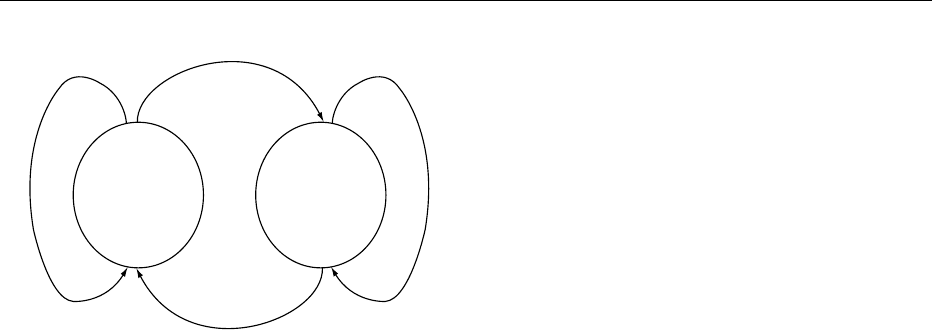
ends with the output of numerical data (Figure 1).
This distinguishes it from image processing where
both input and output are in the form of an image.
0002 Image processing is the means by which the input
image is modified by one or more mathematical algo-
rithms to generate an output image that is enhanced
in some way. For example, edges may be enhanced or
the noise reduced. Image processing is often used to
prepare images prior to analysis.
0003 Image analysis requires specialized computer equip-
ment fitted with an imaging device, such as a television
camera, coupled to a microscope or a macroviewer.
0004 The first commercial image-analyzing computers
were constructed in the early 1960s for grading steel
by measuring nonmetallic inclusions. The value of
using an automated method for the rapid, objective
measurement of images was soon recognized for
many different applications in life and materials
sciences. Image analyzers with greater versatility
have been developed but initially the application of
the technique was limited by the high cost of the
instrumentation. However, the price of computer
hardware has steadily decreased over the years
and now many manufacturers offer relatively
inexpensive systems using a personal computer as
the host processor. With the advent of more afford-
able equipment, applications have proliferated in
many widely differing fields, including food science
and technology.
Terminology and Nomenclature
0005 Image-processing terminology is mainly derived from
the mathematical functions used (e.g., Laplacian and
Gaussian filters are used for image enhancement).
These terms may not always be easy to understand
but are used universally and can, in the main, be used
without ambiguity. This cannot be said for image
analysis. There are no internationally agreed stand-
ards and the terminology used can be specific to the
manufacturer of the equipment. Indeed, in the early
years of image analysis it seemed almost obligatory
for each new analyzer on the market to come with its
own set of terminology. For example, one manufac-
turer uses the term segmentation for the process of
extracting a binary image by gray-level thresholding.
Another calls this process detection and reserves the
term segmentation for the process of separating
touching regions. Also, the binary regions to be meas-
ured can be referred to as regions, objects, features, or
even blobs, depending on the equipment used. This
makes it difficult for newcomers to read research
papers and relate the functions named to those
installed on their own equipment.
0006This situation, although regrettable, is unlikely to
change. The terms used in this article are those most
commonly used but the reader should be aware that
they are not unique.
The Hardware
0007There is a wide range of image analyzers commer-
cially available. They all differ in detail but are
broadly similar in design. A typical system consists
of the following components.
Microscope
0008This is usually fitted with a trinocular head to allow
direct viewing of the specimen and for the mounting
of a television camera. (A macroviewer is an alterna-
tive optical input device for photographs or larger
specimens.)
Television Camera
0009Most image analyzers use standard-format charge-
coupled device (CCD) TV cameras, although an
increasing number of systems are being fitted with
color and high-definition cameras.
Analog-to-Digital Converter (ADC)
0010This is a device that converts the continuous voltage
output signal from the camera into a sequence of
numbers representing the voltage at timed sampling
intervals. The lighter the region of the picture at the
sampling point, the higher the voltage and hence the
larger the numerical value. Most systems are fitted
with an 8-bit converter, allowing 2
8
¼256 different
gray-levels. Three independent channels are used
for color images – one each for the red, green, and
blue images that constitute a conventional real-color
image.
Data
Image
Image synthesis
Image analysis
Data processing
Image processing
fig0001 Figure 1 Conversion of information between data and image
format.
MICROSCOPY/Image Analysis 3935

Image Store
0011 The sampling interval of the ADC is chosen to give a
discrete number of pixels (an abbreviated term for
picture elements) for each scan line of the television
signal. These are read into an image store. The format
for the image store is a matrix of pixels corresponding
to the CCD format of the camera. The store is usually
large enough to accommodate several digitized
images at once. Systems based on personal computers
use buffers within the random access memory.
Monitor
0012 This displays the images and provides a user interface
for programming. Most image analyzers use a
scripting language to build programs that control
the processing of the images and the analysis of the
data.
Image Processor
0013 Digitized images are very large arrays of numerical
data. Early instruments had specialized image proces-
sors to manipulate the images but modern personal
computers have processors powerful enough to cope
with the demands of image processing without using
special processors.
Binary Image Store
0014 In most applications the image will ultimately be
reduced to a binary form where each pixel of the
original image is converted to either a 1, representing
a pixel within an area occupied by one of the objects
to be measured, or a 0 representing a pixel in the
background. Binary images are normally displayed
either as bright pixels on a dark background or by
the use of two distinct colors representing the 0s
and 1s.
0015 Early instruments had specialized memory stores
for this type of data but these are now obsolete.
The Host Processor
0016 This is often, but not necessarily, a personal com-
puter. On older machines it is used to manage the
data flow within the computer and issue instructions
to the specialized processors. Now all the processing
is usually done using the standard computer proces-
sor. The host processor also supervises peripheral
devices such as printers and the automatic focus and
x,y stage controls on the microscope (where fitted).
Finally, it provides the means to process the data and
provide any statistical, graphical, or other utility pro-
gram that may be required for a particular applica-
tion. The host processor will usually be fitted with
disk drives for the storage of data and programs.
Output Device
0017This will commonly be a printer or plotter that will
enable the results to be converted into hard copy in
graphical or tabular form.
The Principles of Image Analysis
0018Image analysis often requires a greater degree of care
in preparing the sample and setting up the microscope
than is necessary for visual inspection. The human
brain is well adapted to the recognition of objects of
interest in an image and to ignore extraneous infor-
mation. The computer, on the other hand, can only
cope with relatively simple images. For this reason the
image analysis process should be considered to start
from the sample preparation onwards.
0019Measurements can only be made on a binary
image. The ultimate goal of the image prepossessing
is to simplify the image in such a way that will make it
easy to convert it to this form. In the binary image the
bright pixels should correspond to those areas in the
original image that represent the objects or structures
that are to be measured.
0020A typical sequence will include the following steps.
Sample Preparation
0021Small variations in the preparation protocol can de-
termine whether or not a project is amenable to image
analysis. The best images for analysis are those that
show the objects that are to be measured in greatest
contrast with respect to the rest of the image. Color
contrast may be used with those instruments fitted
with a color camera. Intensity contrast is used for
monochrome images.
Image Capture
0022The analysis proceeds by setting up the input device
to deliver the best possible image to the camera.
When a suitable image is obtained, it is read into the
computer memory via the ADC.
Image Processing
0023There are many methods of mathematically process-
ing an image so that the output image is enhanced in a
manner that renders it more suitable for image analy-
sis. For example, the edges of structures may be
sharpened or the image may be given enhanced con-
trast or reduced noise.
0024It is not always necessary to preprocess the image
in this way, but shading correction is almost always
used. Shading correction is the process by which the
computer attempts to compensate for any uneven
illumination of the specimen. This is usually achieved
by storing the pattern of the variation in intensity
3936 MICROSCOPY/Image Analysis

obtained from a blank image field. This image, called
the shading pattern, is used to correct subsequent
images.
0025 Image processing can never increase the informa-
tion content of an image. Any enhancement of
one image attribute is obtained at the expense of
another. For example, edge enhancement algorithms
tend to increase the noise content of an image. Many
algorithms have been developed over the years to
enhance images with the minimum of unwelcome
side-effects. There are, for example, methods of
reducing noise without smoothing out the edges of
objects. However, heavy processing can still intro-
duce unwanted artifacts in the image. For this reason
sample preparation and lighting conditions are best
chosen to reduce the need for image enhancement to a
minimum.
Segmentation
0026 This is the process by which the digitized, gray,
or color image is converted into a binary image
representing the objects to be measured. This is the
most important, and often the most difficult, step in
image analysis. The computer needs a binary image
to make measurements. There are several ways of
defining the regions to be segmented. The simplest
form is by setting a gray-level value below which
(or above, for light objects) a pixel will be counted
as being part of the object. All other pixels will
be counted as belonging to the background. This
form of segmentation is also referred to as threshold-
ing or detection. Another method allows the operator
to draw round or point to a typical region; the com-
puter will sample the intensities of the pixels in the
region and generate a binary image of all regions
containing pixels with matching intensities. There
are also methods that specifically detect the edges of
objects.
0027 Color discrimination provides an alternative
method of segmentation for true color images. There
are two main color models used in image analysis–the
red, green, blue (RGB) model and the hue, luminance,
saturation (HLS) model. Color images are separated
into their three components (RGB or HLS) according
to which color model is to be used for segmentation.
Each component is held in memory as a separate
image. These component images can be viewed separ-
ately as monochrome images but are normally dis-
played combined as a color image (Figure 2).
Segmentation methods, similar to those used on
monochrome images, are applied to each of these
components and the resultant binary images com-
bined. The resultant binary image will represent
those regions in the original image that have a similar
color composition.
Binary Image Processing
0028Often the segmentation process does not produce a
perfect binary image of the objects of interest and
many binary operations have been devised to amend
the defects in the image. For example, there are oper-
ations for filling in holes and others that dilate or
erode the binary image by adding or subtracting
pixels from the perimeter of objects. Erosion and
dilation can often be used to good effect by combin-
ing them to form new operations known as closing
and opening. Closing is the process of dilation
followed by an equal amount of erosion and is useful
for joining up fragmented regions of an object.
Opening is the converse operation and is often used
to clean up ragged edges and remove small or thin
artifacts from the image. Opening and closing oper-
ations leave the overall size of the objects relatively
unchanged compared with erosion or dilation used on
their own.
0029There are other more complex binary operations
which can be used, for example, to separate touching
objects, reduce objects to a skeletal representation,
and erode objects to the point just before they
would otherwise disappear. These tools allow the
image analyst to automate much of the editing of
binary images that would otherwise have to be done
by time-consuming manual methods. They form an
important part of image analysis and can make the
difference between being able or otherwise to per-
form an analysis in a reasonable time. The theory
behind these operations is known as mathematical
morphology.
Editing
0030The binary image can be edited manually by using a
hand-held device, such as a mouse or a light pen,
which is interactive with the computer. By this
means sections or lines can be cut out or drawn in at
will. Although it is often necessary to do a little
manual editing, this should always be regarded as a
method of last resort since it is a slow operation and
introduces a subjective element into the analysis.
Measurement
0031There are two distinct modes of measurement that can
be made in image analysis: field-specific and object-
specific. Before discussing these it is important to dis-
tinguish between the image and measurement frames.
The total area of the specimen scanned by the TV
camera and displayed on the monitor forms the image
frame. The measurement frame is a subframe within
the image frame over which the measurements are
made. The area within the image frame that lies outside
the measurement frame forms the guard region.
MICROSCOPY/Image Analysis 3937
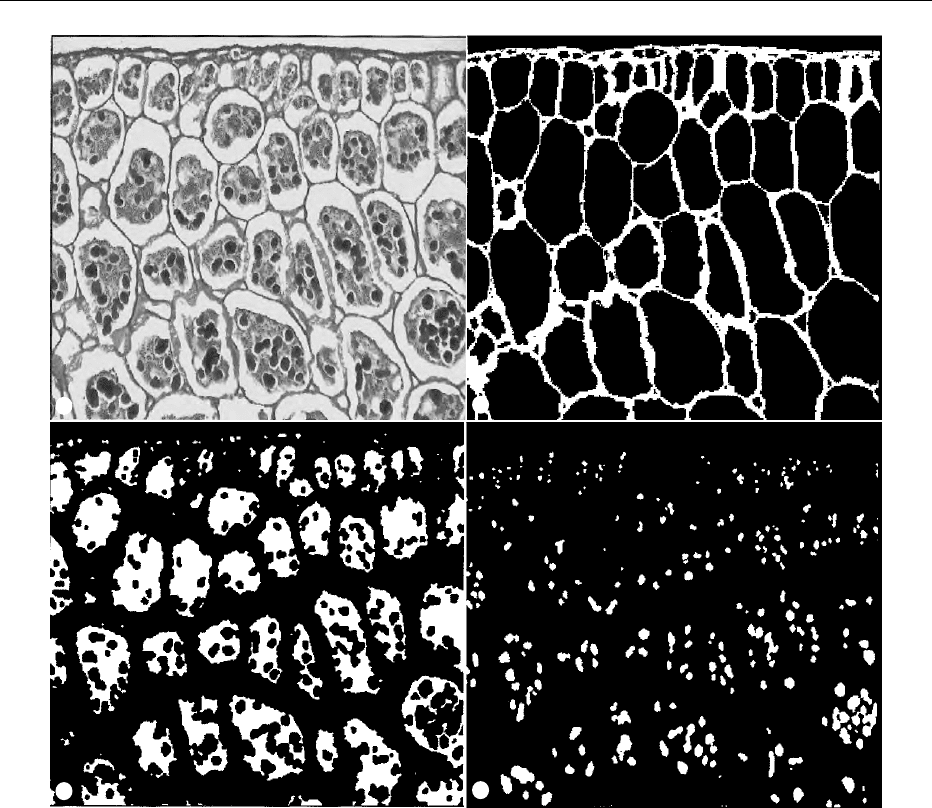
0032 Field-Specific measurements Field-specific meas-
urements are summed over all the objects and parts
of objects lying within the measurement frame. In this
mode, if an object is intersected by the edge of the
measurement frame, only those parts of the object
that project into the frame are measured. Field-spe-
cific measurements are used for stereological calcula-
tions of global parameters such as phase volume or
count per unit volume.
0033 Object-specific measurements Object-specific meas-
urements are made on each individual object in the
measurement field. In this mode, each object is asso-
ciated with a unique object location reference point
that is determined by the counting logic of the par-
ticular image analysis equipment used. The whole of
an object is measured if its reference point is inside
the measurement frame, even if much of it spills over
the edge of the frame. Conversely, the object will not
be measured at all if the reference point falls outside
the frame. Any uniquely definable point may be
chosen as the reference but, for practical reasons,
the location of the last pixel visited within the object
as the scan progresses down the screen is most com-
monly chosen. The measurement frame size is chosen
so that the guard region, which surrounds it, is wide
enough to insure that any object whose location point
is within the measurement frame is wholly within the
image frame.
0034Some primary measurement parameters for objects
are defined below. Most of these measurements can
also be made in field-specific mode:
.
0035Area: the total number of pixels within an object
.
0036Perimeter: the length of the boundary between an
object and the background
a
c
d
b
fig0002 Figure 2 (see color plate 109) Color segmentation of a section from a pea cooked from frozen. (a) Original image; (b) cell walls;
(c) cytoplasm; (d) gelatinized starch granules.
3938 MICROSCOPY/Image Analysis
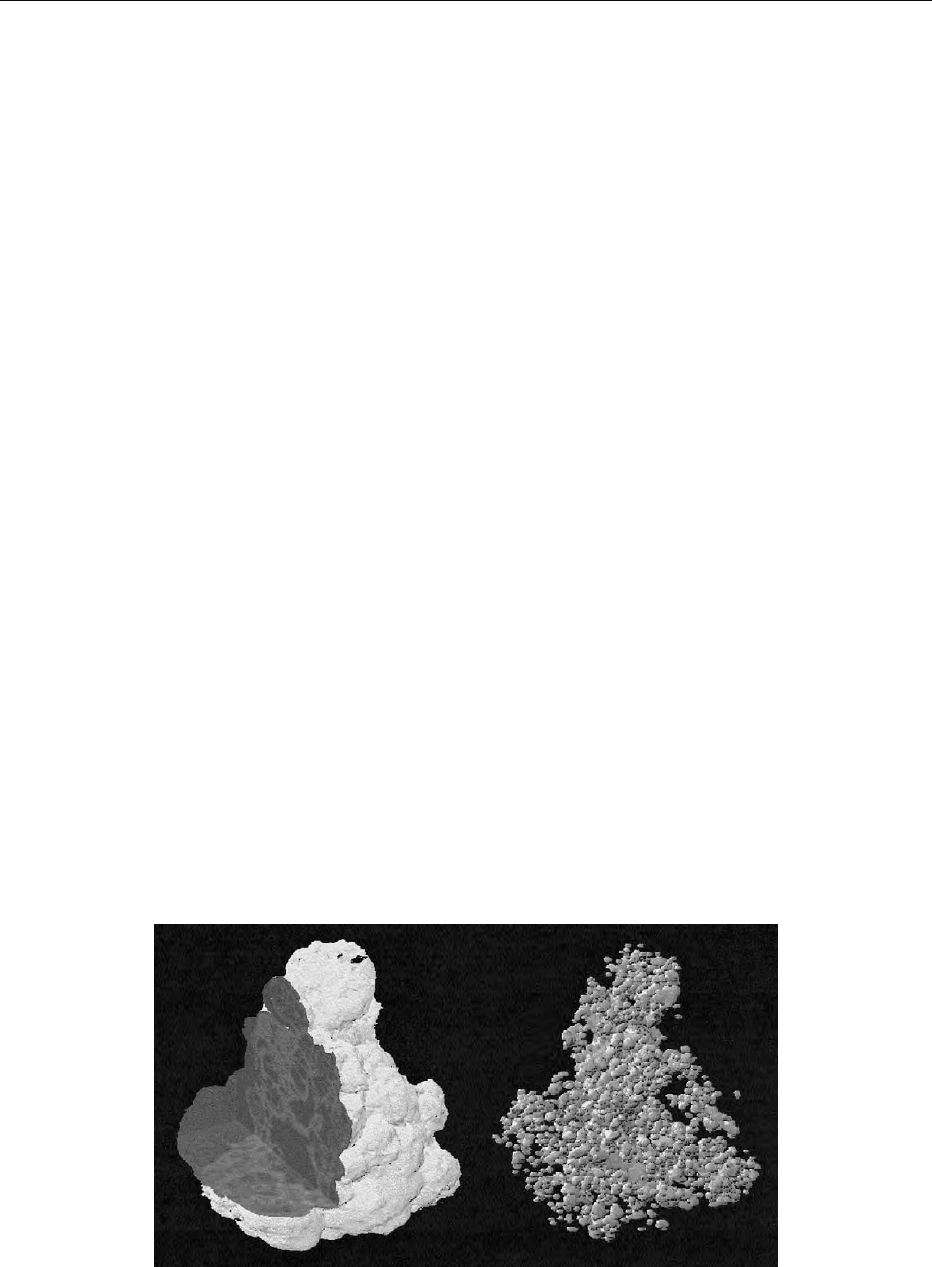
.0037 Horizontal intercept: the number of intersections
of the TV scan line with an object
.
0038 Vertical intercept: the equivalent of the horizontal
intercept but in a vertical direction
.
0039 Feret’s diameters: These are equivalent to caliper
diameters, i.e., the perpendicular distance between
the parallel jaws of a caliper just touching the
object. The magnitude of these measurements is
dependent on orientation and the more advanced
image analyzers are able to measure Feret’s
diameters at a large number of small angular incre-
ments.
.
0040 Integrated brightness: The gray-level values sum-
med over the region corresponding to the binary
image of the object. With suitable calibration, these
measurements can be converted to optical density
values.
.
0041 Count: In field-specific mode this gives the total
number of objects in the field. It may also be pos-
sible, on some machines, to count objects within
objects (e.g., the number of vacuoles within a cell
membrane).
0042 These primary measurements are often combined
to create additional measurement parameters such as:
.
0043 Equivalent circle diameter: The diameter of a circle
having the same area as the binary image of the
object. Used as a size measurement that is insensi-
tive to the orientation of the object.
.
0044 Form factors: The dimensionless ratios of primary
measurements whose magnitude gives an indica-
tion of the morphology of an object. Dimensionless
ratios are used to give values that are independent
of size, e.g.:
Circularity ¼ 4p area=perimeter
2
A perfect circle will have a circularity value of one.
All others shapes will give a lower value.
.
0045Length: Usually taken to be the longest Feret’s
diameter.
.
0046Breadth: This can be defined in a number of ways.
For example, the shortest Feret’s diameter may be
used or it may be estimated by dividing the area by
the largest Feret’s diameter. There are other ways of
defining breadth; the choice will depend on the
application.
Three-Dimensional Imaging
0047One of the restrictions of image analysis has been the
need to work on two-dimensional sections. Volumetric
properties have to be derived from stereological com-
putations. Whilst this approach is sufficient for most
work, it does have significant drawbacks: care must be
taken with anisotropic materials to avoid biasing the
data and the sectioning process may mechanically dis-
tort the material. Furthermore, it is necessary to fix and
embed soft or friable material specimens in order to
section them. This may lead to further structural
changes in the material, thus rendering any measure-
ments of dubious relevance to its original state.
0048There is a number of methods for imaging beneath
the surface of structures. Confocal microscopy,
magnetic resonance imaging, and microfocus X-ray
tomography can be used to provide series of two-
dimensional, virtual sections. Many image analysis
packages have software specifically designed to
reconstruct three-dimensional images from a series of
images representing two-dimensional slices generated
by these methods (Figure 3). The reconstructed images
can be used to create further virtual sections in any
direction or to make direct volumetric measurements.
fig0003 Figure 3 (see color plate 110) Reconstruction of puffed wheat from X-ray tomographic sections. Left, reconstruction with cut-out
to show the internal structure; right, reconstruction of the voids inside the puffed wheat. Courtesy of Dr Paul Jenneson, Surrey
University, UK.
MICROSCOPY/Image Analysis 3939
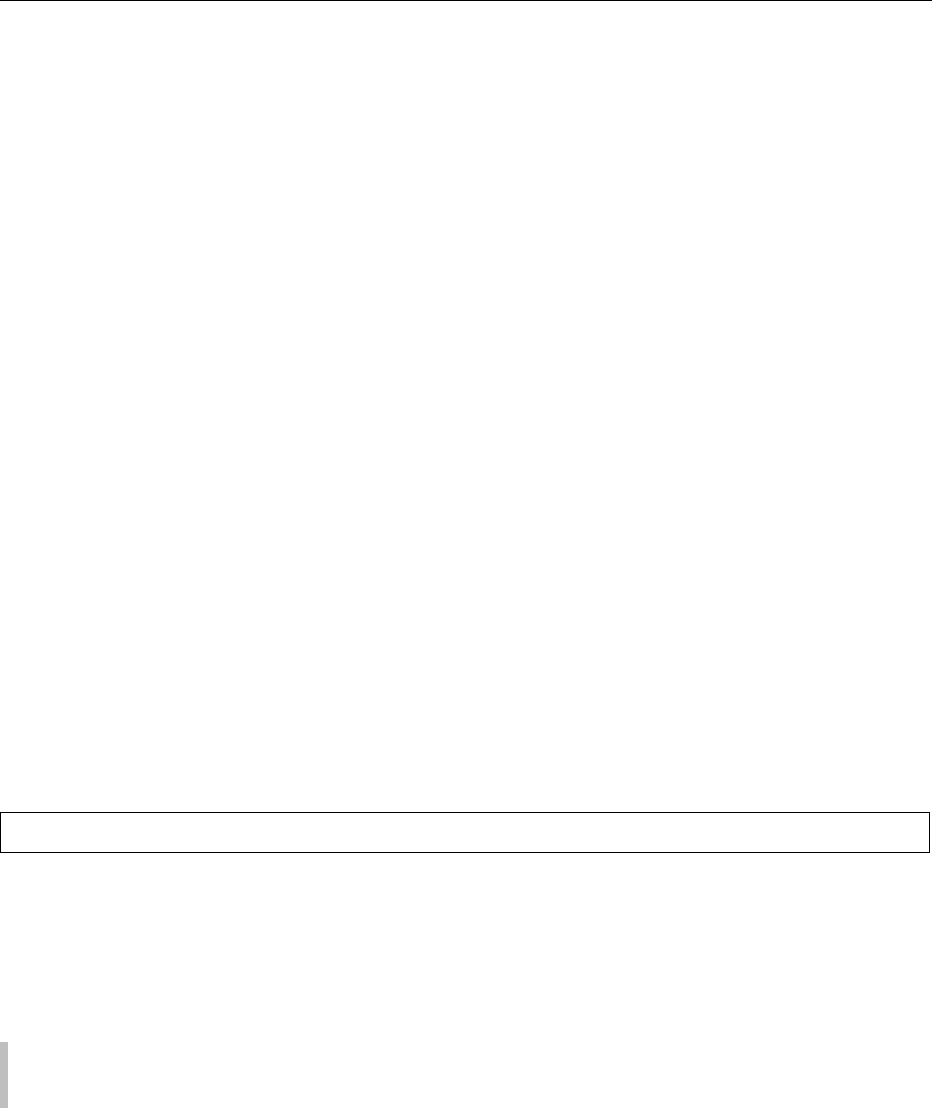
Applications
0049 The potential for applications of image analysis is
enormous – anywhere where rapid, objective, quanti-
tative measurements are required. Particle size and
shape analysis can be used to monitor comminution
or agglomeration processes. The technique has also
been used to measure the air bubble size distribution
in aerated products such as icecream, chocolate, and
batters. Where objects have well-defined morpholo-
gies, shape discrimination can be used to count
several components simultaneously, e.g., counting
the population densities of lactobacilli and strepto-
cocci in yogurt.
The Future
0050 The development of high-resolution scanners for
computer document archiving and the advent of
high-definition TV technology has provided a
number of high-resolution image input devices. This,
coupled with the relentless pursuit of even cheaper
and faster computer memory chips, will provide the
image analyst with access to much higher-resolution
images; 1024 1024 pixel image matrices are already
commonplace and larger formats will follow.
0051 The latest image analyzers use standard computer
components. The only specialized hardware is the
frame-grabber board. New computer interfaces are
being developed that will allow the fast transfer of
data directly into the computer from a digital camera.
This will reduce the cost of the equipment further
and will make image analysis more available to cost-
sensitive applications.
0052Three-dimensional analysis is already an option on
many image analyzers. Its use is restricted due to the
huge amount of memory required and the high
demands made on the processor. These restrictions
will become less relevant and this type of analysis will
become more common in the future.
0053Most electron microscopes and all of the newer
forms of microscopy (e.g., scanning tunneling, atomic
force, and confocal) are controlled via an interface to
a personal computer. These provide an ideal platform
for image processing and analysis.
See also: Microscopy: Scanning Electron Microscopy;
Transmission Electron Microscopy
Further Reading
Gonzalez RC and Wintz P (1977) Digital Image Processing.
Reading, MA: Addison Wesley.
Russ JC (1990) Computer Assisted Microscopy. New York:
Plenum Press.
Serra J (1982) Image Analysis and Mathematical Morph-
ology. London: Academic Press.
Microwave Cooking See Cooking: Domestic Techniques; Domestic Use of Microwave Ovens
MIGRAINE AND DIET
M R Costa and M B A Glo
´
ria, Federal University of
Minas Gerais, Belo Horizonte, Minas Gerais, Brazil
Copyright 2003, Elsevier Science Ltd. All Rights Reserved.
Migraine Headache
0001 ‘Migraine’ is a French derivative of the Greek word
for hemicrania, or half a head. The problem of mi-
graine is of long standing. Aretaeus of Cappadocia, in
the second century ad, defined migraine as ‘a parox-
ysmal headache disorder that occurred on one side
of the head and then the other, recurred at regular
intervals, associated with vomiting and photophobia,
and ameliorated by dark surroungings.’
0002Throughout the ages, migraine has been a problem
to patients and an enigma to physicians. Migraine is a
public health problem of enormous scope that has an
impact on both individual sufferers and society. Sev-
eral studies have indicated that 82–85% of individ-
uals have some headache-related disability. About
one-third of them are severely disabled or need bed
rest. In addition, many live in fear, knowing that at
any time an attack could disrupt their ability to work,
care for their families, or meet social obligations.
With regard to the impact on society, the costs in
3940 MIGRAINE AND DIET

human terms are overwhelming. The totals, in terms
of lost production, medication, doctors’ and hospital
fees are huge.
0003 Migraine may begin in childhood and usually starts
before the age of 40. Its prevalence in childhood is
about equal among girls and boys, but at puberty
the two groups diverge sharply and females begin to
outnumber males. Frequency tends to decrease with
advancing age, and up to three-fourths of women
note relief after menopause.
0004 It is believed that sufferers from migraines may
have an inherited predisposition for this disorder. It
has been reported that 50–70% of patients with mi-
graine have a positive family history. The precise
mode of inheritance is not known, but current
thought is that this predisposition is an autosomal
dominant trait characterized by incomplete pene-
trance.
Symptoms of a Migraine Headache
0005 The symptoms most frequently associated with mi-
graine headache are indicated in Table 1. Migraine is
characterized by throbbing head pain. Most of the
time, it is unilateral in adults; pain may occur on
either side of the head but rarely changes sides during
an attack. In children, migraine is ordinarily bilateral.
It is often accompanied by nausea and sensitivity
to light and/or sound. Less frequently noted are
abdominal bloating and diarrhea, pallor, sweating,
chills, and cold extremities. Every individual is
different and may experience some symptoms and
not others, or in various combinations. Intensity
varies from one attack to another.
0006The frequency of migraine ranges from every few
days to less than once a year. However, most patients
experience one to four attacks a month. These gener-
ally last from 4 h to 2 days, but severe episodes of
prolonged migraine may persist for weeks. Proper
management can significantly reduce the impact of
this debilitating chronic disorder and improve both
functioning and quality of life.
Pathophysiology of Migraine
0007Migraine is a vascular headache believed to be caused
by blood flow changes and certain chemical changes
in the brain leading to a cascade of events, including
constriction of arteries supplying blood to the brain
and the release of certain brain chemicals.
0008Migraine has a number of forms, some of which
may be confused with other diseases. It can be classi-
fied (Table 2) as migraine with aura (classic) and
without aura (common).
0009The exact cause of migraine is uncertain,
although various theories are being studied. The
neurogenic theory emphasizes the significance of
active substances acting upon the central nervous
system and promoting intracerebral vasoconstriction
and extracranial vasodilatation. According to many
researchers, migraine is due to the vulnerability of the
nervous system to sudden changes in either the body
or the surrounding environment. They believe that
migraine sufferers have inherited a more sensitive
nervous system response than those without mi-
graine. During a migraine attack, changes in brain
activity produce inflamed blood vessels and nerves
around the brain.
0010Another theory is that migraine represents a dis-
order of cerebrovascular regulation. In the typical
migraine sequence, a trigger precipitates a cascade
of events that includes release, activation, and pro-
duction of active substances. When these substances
tbl0001 Table 1 Symptoms associated with migraine headache
Symptoms of migraine headache
Moderate to severe headache pain
Duration of 4–48 h, sometimes longer
Throbbing pain located on one side of the head
Nausea
Vomiting
Sensitivity to light, sound, or odors
Pain becomes worse when moving
tbl0002 Table 2 Symptoms and signs of different forms of migraine
Types ofmigraine Characteristics
Migraine with aura (classic) Neurologic symptoms occur 15–60 min before headache: scotomas or blind spots
are common; photopsia and teichopsia or fortification spectra occur frequently;
diplopia, macropsia, and metamorphopsia are less common
Headache begins as neurologic symptoms diminish
Migraine without aura (common or nonclassic) Occurs in 85% of all patients
No neurologic aura precedes the headache
Premonitory disturbances of mood or appetite (craving for sweets, euphoria,
fatigue, yawning) can happen 1–3 days before an attack
Bilateral or generalized pain
MIGRAINE AND DIET 3941
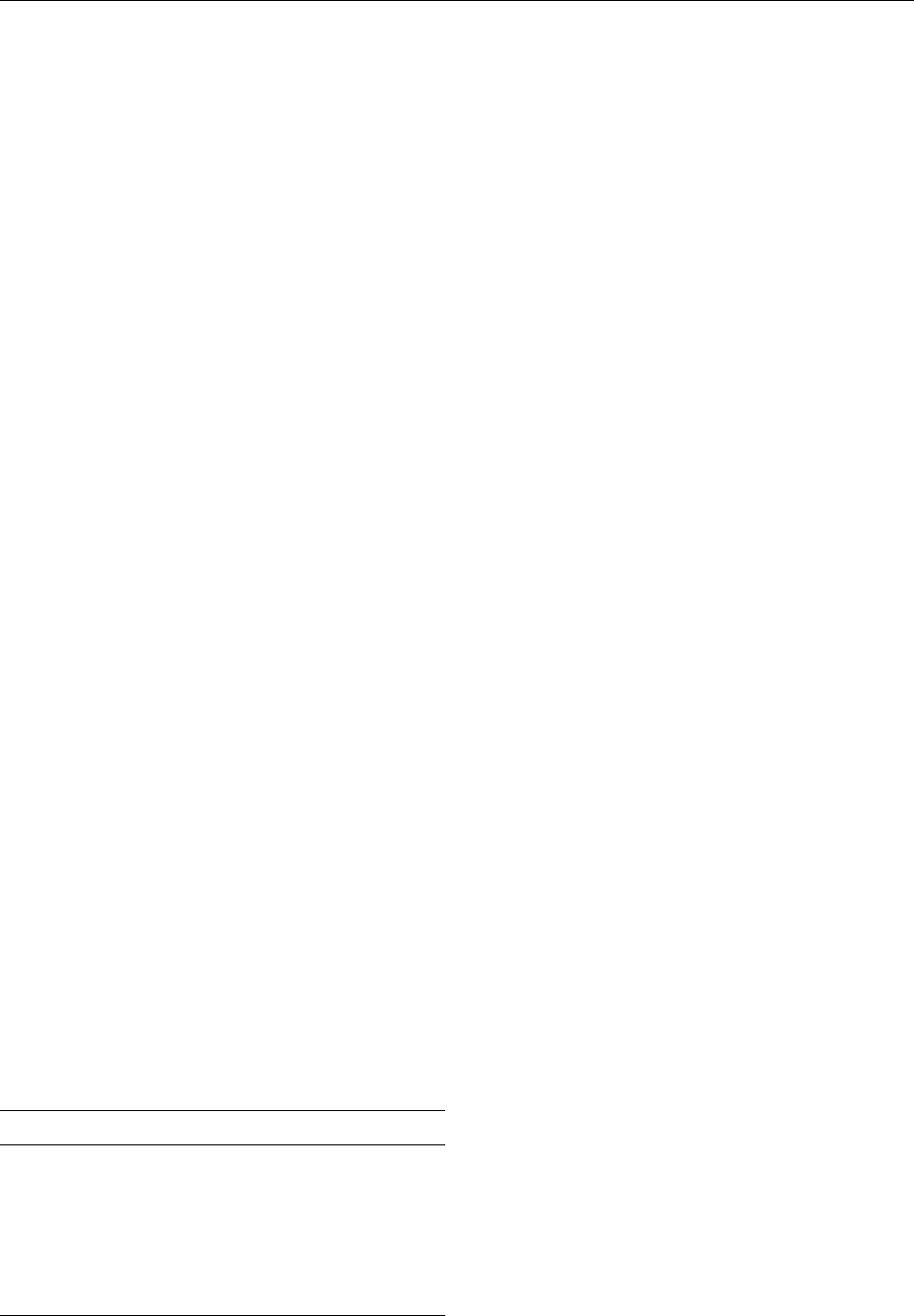
concentrate in the tissue, vascular and nervous phe-
nomena are enhanced. A fact of paramount import-
ance is that some of these substances potentiate
one another. In patients with regular attacks, each
episode of migraine is followed by a phase of immun-
ity and then by one of increasing reactivity, which
can be divided into two stages. The first is called
adrenergic, and is characterized by relatively mild
symptoms, such as no pain, vasoconstriction, slight
excitation, and sensory manifestations. In the second
one, there is intense pain, marked vasodilatation, and
pronounced psychic depression. During the reactive
phase, migraine episodes may be triggered by stimuli
that promote vasoconstriction (e.g., cold, anxiety) as
well as vasodilatation (e.g., heat, alcohol, nitrites).
Triggers or Provokers of Migraine
0011 Certain factors can provoke or trigger attacks more
frequently in those susceptible to migraine headache.
Some possible triggers include biochemical or envir-
onmental factors; hormonal changes in women; too
much or too little sleep; stress (feeling overly tired);
pharmacological precipitants; and diet. According to
many studies (Table 3), the most commonly cited
triggers are stress, change in sleep patterns, menstrual
cycle, hunger, and diet or specific foods. Not all mi-
graines have the same provoking factors, nor do all
these factors necessarily provoke an attack. Migraine
can also arise from a number of factors acting in
unison.
Biochemical Factors
0012 It has been postulated that there is a biochemical
defect in migraine sufferers, especially with respect
to their ability to metabolize amines and phenols
when compared to controls. The monoamine oxi-
dases (MAO) act as a barrier against the absorption
of vasoactive substances contained in foods. MAO
defect can prevent amine metabolism and, therefore,
cause accumulation of monoamines. There could also
be a deficiency of phenolsulfotransferase P, which is
specific for the detoxification of dietary phenols.
Environmental Triggers
0013Environmental triggers of migraine headache include
weather or temperature changes, exposure to bright
lights (glare from snow or fluorescent lights, com-
puter screens), loud noises, and strong odors. High
altitudes or the atmosphere of a pressurized cabin in a
commercial airliner may also lead to migraine attacks
or similar vascular headaches.
Menstrual Cycle
0014Many women with migraine have attacks linked to their
menstrual cycles. Menstrual migraine occurs mainly
between 2 days prior and 3 days following the onset of
flow. It is usually related to changing levels of menstrual
hormones during menstruation, puerperium, hysterec-
tomy, and pill-taking. Migraine prevalence peaks in
womenintheirearly40sandthendeclinessteadily
with age. Migraine may worsen in early pregnancy, but
it generally improves in later pregnancy. Although some
women find that their migraines worsen when taking
oral contraceptives, the majority experience no change
or improvement in their headache pattern.
Pharmacological Agents
0015Some pharmacological agents used to treat hyperten-
sion and coronary artery disease may increase mi-
graine frequency. Reserpine may increase migraine
frequency and exacerbate depression in some pa-
tients. Amyl nitrite, used for treatment of angina
pectoris, may adversely affect the frequency of mi-
graine. Migraine was observed after beginning 25 000
IU daily supplementation of vitamin A.
0016Headache potential is also increased in patients
treated with MAO inhibitor drugs, such as phenyl-
zine, isocarboxazid, pargyline and tranylcypromine
for depression; iproniazid and isoniazid for tubercu-
losis; procarbazine hydrochloric for cancer; and
furazolidone for antimicrobial use.
Emotional Stress and Anxiety
0017Stress is the most common migraine trigger. Emo-
tional stress or response to life’s daily pressure can
trigger migraine attack in some individuals. Stress
can cause alteration in adrenal hormone level. Stress,
fear, and anger may liberate vasoactive substances
from tissue stores.
0018Depression has been associated with migraine in both
prospective and retrospective epidemiological studies,
and psychological distress has been shown to be respon-
sive to cognitive-behavioral headache interventions.
Sleep Patterns
0019An extra 1–2 h sleep can be enough to initiate a
headache. The mechanism involved is not understood
tbl0003 Table 3 Major precipitating factors in migraine
Precipitating factors Frequency (%)
Heredity 66
Stress, anxiety, and worry 43–88
Change in sleep patterns 77
Menstrual cycle 39–65
Oral contraceptive 31
Bright light 30
Diet or specific foods 13–74
Fasting 7–77
3942 MIGRAINE AND DIET
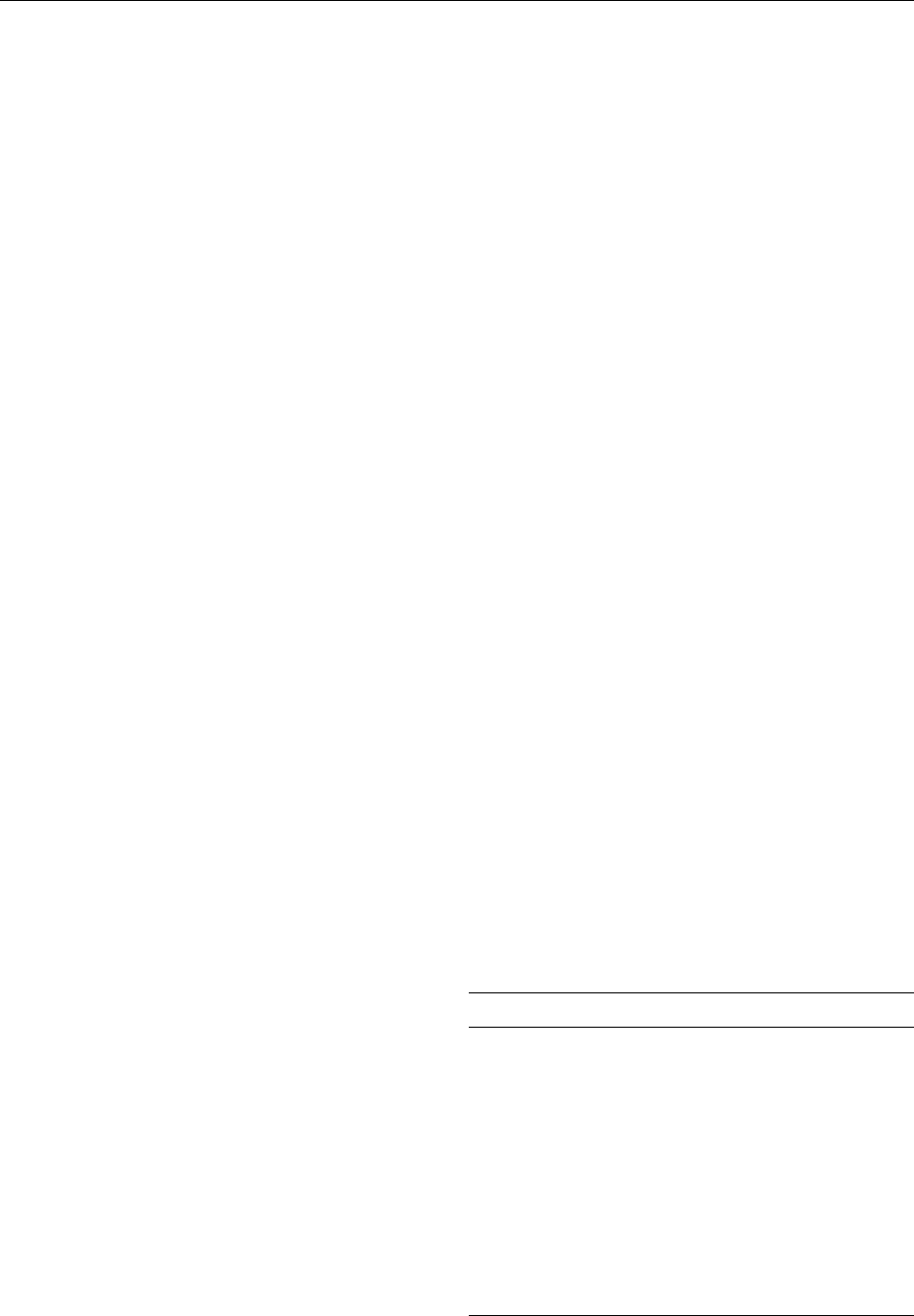
but carbon dioxide retention with vasodilatation or
delayed breakfast provide two possibilities. However,
lack of sleep for social or work reasons, as well as
psychological factors, can be a migraine precipitant.
Hunger and Hypoglycemia
0020 Blood glucose levels have important effects on the tone
of cerebral blood vessels. Marked cerebral vasodilata-
tion may occur if blood glucose levels are reduced by
insulin or other causes. Therefore, hunger headache
can occur during fasting or food deprivation. It is
provoked after stopping food intake for 5 h during
the day or 13 h overnight. This condition may also be
responsible for the weekend headache that develops
when a person sleeps late and delays the morning
meal. Since blood glucose levels do not fall below
normal levels, it cannot be called hypoglycemia. How-
ever, hypoglycemia has also been associated with
headache. It is a prominent symptom in a patient
entering insulin shock. In addition, the reactive hypo-
glycemia that occurs after ingestion of a large simple-
carbohydrate meal may also precipitate a similar
headache in susceptible persons. Therefore, in order
to reduce the number and severity of migraines, a
patient should not skip meals, should have three or
more well balanced meals a day and should avoid
overabundance of carbohydrates at any single meal.
Cold Drinks or Icecream
0021 Swallowing cold drinks or icecream can quickly cause
a brief frontal icecream headache lasting a few min-
utes. The pain occurs either in the palate and throat or
the forehead, temple, or ear. The cause is believed to
be the sudden cooling of the oral pharynx. Icecream
headache is an excessive vascular reaction to cold and
a manifestation of erratic vasomotor regulation in
patients with migraine.
Allergy
0022 There is a very long medical history which attempts
to relate migraine to allergy. However, the view of
many researchers in the field of migraine appears to
be that dietary migraine is not an allergic phenom-
enon. Recently, it has become evident that the
immune system might be affected in migraine. Foods
such as milk, wheat, eggs, and meat are usually in-
volved. In patients with migraine, these foods induce
formation of immune complexes which can release
active substances. They may also react with mast
cells, releasing histamine and serotonin.
Influence of Diet
0023 Studies on the influence of diet on migraine are diffi-
cult to evaluate. A diet trial cannot be performed in a
double-blind manner. Moreover, it is hard to reduce
selectively one or a couple of components in the diet
and yet preserve the original proportions of nutrients.
Diet trials are also difficult to carry out with regard to
compliance and practical inconvenience for the
patients.
0024Although the relationship between diet and mi-
graine has been a source of controversy for many
years, certain relationships have become clear. Some
specific foods, alcoholic beverages, and some food
additives are possible triggers of diet-precipitated
migraine, even though sensitivity varies with each
patient.
0025Chocolate, cheese, and citrus fruits are the most
frequently cited provoking factors to which patients
ascribe their dietary migraine (Table 4). Fatty fried
foods, vegetables, tea and coffee, pork, and seafood
have also been cited. In 490 migraine patients
attending the Princess Margaret Migraine Clinic at
Charing Cross Hospital in 1984, 19% cited choc-
olate, 18% cheese, 11% citrus fruit, 29% reported
alcohol, 7% coffee, 3% pork and dairy products, and
2% eggs as precipitants of their headaches. In another
study with 429 migraine patients attending the same
clinic from 1989 to 1991, 17% reported that head-
aches could be precipitated by cheese and chocolate,
and nearly always by both; 18% reported sensitivity
to all alcoholic drinks, while another 12% were sen-
sitive to red wine but not to white wine; and 28%
reported that beer would precipitate headaches.
0026Food-induced headaches are mediated by chemical
constituents common to these foods (Table 5). Some
are naturally occurring components, including tyram-
ine, phenylethylamine, serotonin and other vaso-
active amines, alcohol, flavonoid, caffeine, and
copper. Additives added to foods, such as sodium
nitrite and monosodium glutamate (MSG), may also
elicit migraine headache. Some other food or food
tbl0004Table 4 Major precipitating foods in migraine
Precipitating factors Patients withdietary migraine (%)
Chocolate 17–75
Alcohol 11–67
Red wine 12
Beer 28
Cheese 17–50
Citrus fruits 11–30
Nuts 12–17
Fatty fried foods 18–19
Coffee 7–15
Ham 4
Pork 3–15
Dairy products 3–9
Seafood 6–10
Onion 18
MIGRAINE AND DIET 3943
